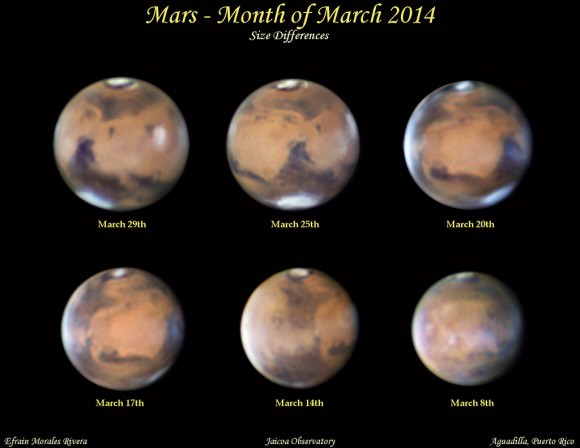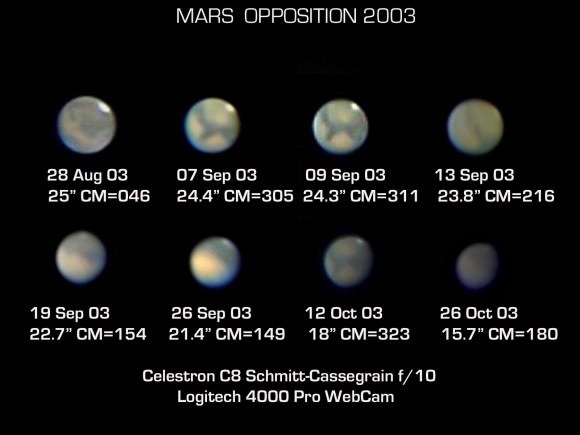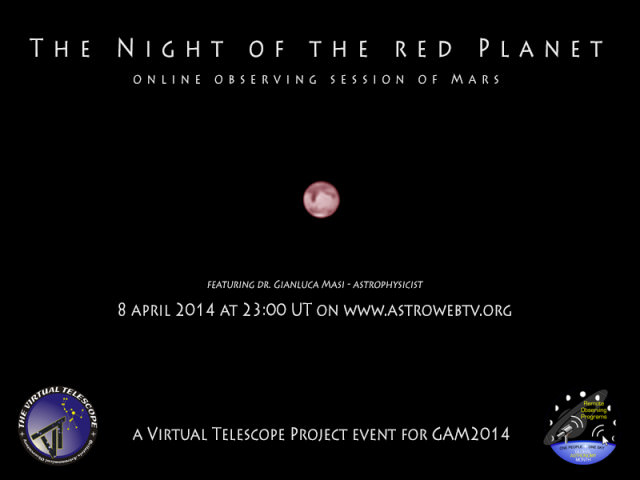Mars attacks and comes to a night sky near you this month, and the folks at the Virtual Telescope Project and Slooh are bringing it to you live and in color. Unlike most planets, “Mars viewing season” comes around only once about every two years. And while Mars is shining bright in the sky right now, the “official” event of Mars being closest to Earth happens next week on April 8th, when the Red Planet reaches opposition and shines at magnitude -1.5 in the constellation Virgo.
We’ve written about the prospects and circumstances for viewing Mars this opposition season; now it’s time to watch it live. The webcast starts at 23:00 Universal Time (UT) or / 7:00 PM EDT on the night of Tuesday April 8th, and will feature real-time images brought to you via robotic telescopes worldwide. Hosted by astrophysicist Gianluca Masi and run in conjunction with Astronomers Without Borders, this online observing session of Mars also occurs during Global Astronomy Month. Anyone who tuned in for their recent online Messier Marathon and live broadcasts of several recent Near-Earth Asteroids past our fair planet knows that they’re in for quite a treat!
Want more? Or simply want dual screen live views of “all Mars, all the time?” Our dependable friends over at Slooh will be chronicling the Mars opposition on the same night, starting at a slightly different bat-time at 02:00 UT (the morning of the 9th) which is 10:00 PM EDT the evening of the 8th. Slooh will be presenting a live feed from its automated telescopes based in the Canary Islands off of the coast of West Africa and will feature live commentary from hosts Paul Cox and astronomer and author of The Sun’s Heartbeat Bob Berman.
“Mars has held disproportionate focus for humans since ancient times,” Berman said in a recent press release. “It is neither the closest planet, nor the largest, nor the most detailed through telescopes. Nonetheless, it is the only planet in the universe that shows distinct and sometimes detailed surface features through our telescopes. It is also the most Earthlike body in the known universe, with oxygen bound into its soil and water contained in its ices. Therefore, during the brief two weeks when it comes near us every 26 months, it deserves the limelight.”
Indeed, Mars has captivated observers ever since Christiaan Huygens sketched the first blurry surface feature Syrtis Major back in 1659. Percival Lowell enthralled the public imagination with his sketches of what he thought were canals built by an intelligent and ancient civilization on the Red Planet, and astronomer David Peck Todd once proposed to signal said Martians via balloon aloft in 1909. The SETI Institute’s Seth Shostak noted in his book Confessions of an Alien Hunter that to the average person on the street in the early 20th century, the idea that Mars was inhabited was a given.
Of course, the reality revealed to us by the early Mariner missions in the 1960s onwards paints a bleak picture of a cratered world with a tenuous atmosphere inhospitable to life as we know it.
Still, Mars is a real world, somewhere that rovers are rolling across and exploring even as we peer at it though the eyepiece this month. Six months prior to opposition also the best opportunity to send spacecraft to Mars, and later this year, NASA’s MAVEN and India’s Mars orbiter Mangalyaan both launched in late 2013 will complete the trip.

Observing the Red Planet through the eyepiece is easy. The most conspicuous feature is the white northern pole cap, currently tipped towards us. Orographic clouds have also been imaged by amateurs recently over the Hellas basin, and a planet wide dust storm could always crop up at any time. A Martian day is only 37 minutes longer than the Earth’s, meaning you’re only seeing Mars rotated by about 15 degrees of longitude if you observe it at the same time each night. At about 15” across, you could stack 120 Mars diameters as seen this week from Earth across a Full Moon. And no, Mars NEVER appears as big as a Full Moon as seen from the Earth, not this week, every August, or EVER, despite those pesky chain-emails from well meaning co-workers/friends/relatives who just know that you’re into that “space thing…”
All oppositions of Mars are not created equal. In fact, we’re coming off of a series of lackluster oppositions that’ll see Mars getting successively better until 2018, when it’ll nearly top the historic opposition of 2003. For ephemerides buffs, Mars reaches opposition — that is, it’s 180 degrees opposite to the Sun as reckoned in right ascension — on April 8th at 21:00 UT/5:00 PM EDT. It is not quite, however, at its closest to us for 2014: it has still got 0.003 AU (465,000 kilometres, a little over the distance from the Earth to the Moon) and just over 5 days before its closest approach to Earth on the night of April 14th/15th, when a total eclipse of the Moon lies just nine degrees away. The reason opposition and the closest approach of Mars to Earth are not quite in sync is because the orbits of both planets are elliptical, and while Mars is currently moving towards perihelion, Earth is heading toward aphelion on July 4th.

Can’t wait until the 8th? Universe Today hosts a Virtual Star Party every Sunday evening at 11:00 PM EDT / 03:00 UT on Google+ featuring telescopes and commentary by observers and astronomers worldwide. Weather willing, Mars should be a centerpiece object for the show this Sunday night on April 6th.
Be sure to check out Mars at its best this week for 2014, either in a sky near you or online… hey, maybe we’ll be live casting the transit of Earth, the Moon and Phobos someday from Mars on the slopes of Elysium Mons on November 10th, 2084:
Let’s see, hopefully they’ll have perfected that whole Futurama “head in a jar” thing by then…
Enjoy!

